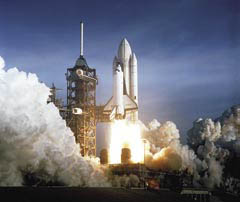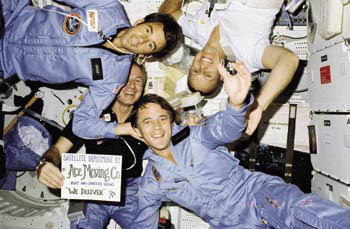1.4 THE SHUTTLE BECOMES "OPERATIONAL"
1.4 The Shuttle Becomes "Operational"
― シャトルの「実用化」―
― シャトルの「実用化」―
On the first Space Shuttle mission, STS-1,*11 Columbia carried John W. Young and Robert L. Crippen to orbit on April 12, 1981, and returned them safely two days later to Edwards Air Force Base in California (see Figure 1.4-1). After three years of policy debate and nine years of development, the Shuttle returned U.S. astronauts to space for the first time since the Apollo-Soyuz Test Project flew in July 1975. Postflight inspection showed that Columbia suffered slight dam-age from excess Solid Rocket Booster ignition pressure and lost 16 tiles, with 148 others sustaining some damage. Over the following 15 months, Columbia was launched three more times. At the end of its fourth mission, on July 4, 1982, Columbia landed at Edwards where President Ronald Rea-gan declared to a nation celebrating Independence Day that "beginning with the next flight, the Columbia and her sister ships will be fully operational, ready to provide economical and routine access to space for scientific exploration, commercial ventures, and for tasks related to the national security" [emphasis added].*12
最初のスペースシャトルのミッション、STS-1では、ジョン・W・ヤングとロバート・L・クリッペンが1981年4月12日に軌道へと向かい、2日後にカルフォルニア州のエドワーズ空軍基地へ無事帰還しました(図1-4-1)。3年のポリシーに関する議論と、9年の開発期間を経て、シャトルは1975年のアポロソユーズ以来、ようやくアメリカの宇宙飛行士を宇宙へと帰したのです。飛行後の調査で、コロンビアは固体燃料ロケットの点火時の圧力が大きすぎたために若干のダメージを受け、耐熱タイルが16枚脱落し、148枚が損傷を受けていることが分かりました。続く15ヶ月間の間に、コロンビアはさらに3回打ち上げられました。そして、1982年7月4日、4回目のミッションの終わりにコロンビアはエドワーズ空軍基地に着陸し、ロナルド・レーガン大統領は独立記念日を祝ってこう宣言しました。「次のフライトで、コロンビアとそれに続く機体は完全に実用段階に入るでしょう。科学的な探査や商業的な新進事業、そして国家安全保障上の任務のために、経済的かつ定期的に宇宙へ出て行くための手段は準備が整いました」(強調追加)

Figure 1.4-1. The April 12, 1981, launch of STS-1, just seconds past 7 a.m., carried astronauts John Young and Robert Crippen into an Earth orbital mission that lasted 54 hours.
図1-4-1:1981年4月12日午前7時。STS-1の打上げ。
宇宙飛行士ジョンヤングとロバートクリッペンが搭乗。地球軌道に54時間滞在しました。
宇宙飛行士ジョンヤングとロバートクリッペンが搭乗。地球軌道に54時間滞在しました。
There were two reasons for declaring the Space Shuttle "op-erational" so early in its flight program. One was NASAs hope for quick Presidential approval of its next manned space flight program, a space station, which would not move forward while the Shuttle was still considered devel-opmental. The second reason was that the nation was suddenly facing a foreign challenger in launching commercial satellites. The European Space Agency decided in 1973 to develop Ariane, an expendable launch vehicle. Ariane first flew in December 1979 and by 1982 was actively competing with the Space Shuttle for commercial launch contracts. At this point, NASA still hoped that revenue from commercial launches would offset some or all of the Shuttles operating costs. In an effort to attract commercial launch contracts, NASA heavily subsidized commercial launches by offering services for $42 million per launch, when actual costs were more than triple that figure.*13 A 1983 NASA brochure titled We Deliver touted the Shuttle as "the most reliable, flexible, and cost-effective launch system in the world."*14
こんなにも早くスペースシャトルが実用段階に入ったことが宣言されたのには2つ理由があります。1つ目の理由は、NASAが次の有人宇宙飛行計画である宇宙ステーションに移行することへの大統領の賛同を得たいと考えたからです。これらの計画はシャトルが開発段階にあるうちは前に進めることができなかったのです。2つ目の理由は、商業衛星の打上げの分野でアメリカに海外の競合が現れたためです。欧州宇宙機関(European Space Agency:ESA)は、1973年に使い捨て型のロケットであるアリアンを開発することを決定し、1979年の12月には初飛行を行いました。そして、1982年には、実際に商業打上げ契約でスペースシャトルと競合するまでになったのです。この時点でも、NASAは商業打上げによる収入がシャトルの運用コストの一部ないし全てを相殺することができると思っていました。商業打上げの契約を取り付けるために、NASAは一回の打上げの費用を4200万ドルで行うことで商業打上げを支援しました。しかし、実際のコストはこの3倍以上かかっていたのです。1993年にNASAが制作した小冊子『We Deliver』では、シャトルのことをこう表現しています。「世界で最も信頼性、汎用性が高く、経済効率のいい打上げシステム」
Between 1982 and early 1986, the Shuttle demonstrated its capabilities for space operations, retrieving two commu-nications satellites that had suffered upper-stage misfires after launch, repairing another communications satellite on-orbit, and flying science missions with the pressur-ized European-built Spacelab module in its payload bay. The Shuttle took into space not only U.S. astronauts, but also citizens of Germany, Mexico, Canada, Saudi Arabia, France, the Netherlands, two payload specialists from commercial enterprises, and two U.S. legislators, Senator Jake Garn and Representative Bill Nelson. In 1985, when four Orbiters were in operation, the vehicles flew nine mis-sions, the most launched in a single calendar year. By the end of 1985, the Shuttle had launched 24 communications satellites (see Figure 1.4-2) and had a backlog of 44 orders for future commercial launches.
1982年から1986年の初頭において、シャトルはその宇宙での活動能力を証明しました。上段ロケットの点火不良に見舞われた2つの通信衛星を回収し、軌道上で別の通信衛星の修理を行い、さらにヨーロッパで建造された与圧した宇宙実験室(SpaceLab)モジュールをペイロードベイに搭載しての科学実験フライトを行いました。シャトルはアメリカの宇宙飛行士だけでなく、同様にドイツ・メキシコ・カナダ・サウジアラビア・オランダの飛行士、企業からの2人のペイロードスペシャリスト、そして二人の国会議員―ジェイク・ガーン上院議員、ビル・ネルソン下院議員を宇宙へ送りました。1985年、4機のオービターが就航し、1年間に9回のミッションがこなされました。1985年の終わりには、シャトルは24の通信衛星を打ち上げ(図1-4-2)、44の商業打上げの受注を得ていました。

Figure 1.4-2. The crew of STS-5 successfully deployed two commercial communications satellites during the first "operational" mission of the Space Shuttle.
図1-4-2:STS-5の乗員。
スペースシャトルの最初の「実用」ミッションにおいて、
2つの商業衛星を軌道に投入することに成功しました。
スペースシャトルの最初の「実用」ミッションにおいて、
2つの商業衛星を軌道に投入することに成功しました。
On the surface, the program seemed to be progressing well. But those close to it realized that there were numerous problems. The system was proving difficult to operate, with more maintenance required between flights than had been expect-ed. Rather than needing the 10 working days projected in 1975 to process a returned Orbiter for its next flight, by the end of 1985 an average of 67 days elapsed before the Shuttle was ready for launch.*15
シャトルプログラムは、表面上は上手くいっているように見えましが、細かく見ると、無数の問題を抱えていました。システムは運用が難しく、予想したよりもフライトの間のメンテナンスに手間が掛かりました。1975年の予測では帰還したオービターが次のフライトを行うために10日の作業が必要と思われていましたが、1985年末の段階で、打上げの準備が整うまでに平均67日間が経過していました。
Though assigned an operational role by NASA, during this period the Shuttle was in reality still in its early flight-test stage. As with any other first-generation technology, opera-tors were learning more about its strengths and weaknesses from each flight, and making what changes they could, while still attempting to ramp up to the ambitious flight schedule NASA set forth years earlier. Already, the goal of launching 50 flights a year had given way to a goal of 24 flights per year by 1989. The permission cost was more than $140 million, a figure that when adjusted for inflation was seven times great-er than what NASA projected over a decade earlier.*16 More troubling, the pressure of maintaining the flight schedule cre-ated a management atmosphere that increasingly accepted less-than-specification performance of various components and systems, on the grounds that such deviations had not interfered with the success of previous flights.*17
NASAは実用段階の役割を課していましたが、実際はシャトルはまだフライトテストの段階にありました。新技術の最初の世代が普通そうであるように、運用者はそれぞれのフライトを通じて、シャトルの強さや弱さを学び、どのような修正が可能かを検討していました。それでもなお、NASAはフライトスケジュールを何年も前倒しにしようと目論んでいたのです。既に、1年に50回という打上げ目標は、1989年までに年間24回という目標に修正されていました。許されているコストは1億4,000万ドル以上、この数字は10年前にNASAが予測したコストの7倍に膨れ上がっていました。さらに問題なのは、フライトスケジュールを維持することへのプレッシャーから、それまでのフライトに支障をきたさなかったという理由で、各コンポーネントやシステムが規定の性能を満たしていなくても許容するという風潮が生まれていたことです。